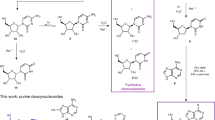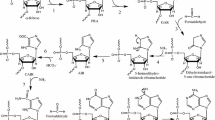Abstract.
Modified purines are found in all organisms in the tRNA, rRNA, and even DNA, raising the possibility of an early role for these compounds in the evolution of life. These include N 6-methyladenine, 1-methyladenine, N 6,N 6-dimethyladenine, 1-methylhypoxanthine, 1-methylguanine, and N 2-methylguanine. We find that these bases as well as a number of nonbiological modified purines can be synthesized from adenine and guanine by the simple reaction of an amine or an amino group with adenine and guanine under the concentrated conditions of the drying-lagoon or drying-beach model of prebiotic synthesis with yields as high as 50%. These compounds are therefore as prebiotic as adenine and guanine and could have played an important role in the RNA world by providing additional functional groups in ribozymes, especially for the construction of hydrophobic binding pockets.
Similar content being viewed by others
Author information
Authors and Affiliations
Additional information
Received: 7 August 1998 / Accepted: 31 December 1998
Rights and permissions
About this article
Cite this article
Levy, M., Miller, S. The Prebiotic Synthesis of Modified Purines and Their Potential Role in the RNA World. J Mol Evol 48, 631–637 (1999). https://doi.org/10.1007/PL00006506
Issue Date:
DOI: https://doi.org/10.1007/PL00006506




